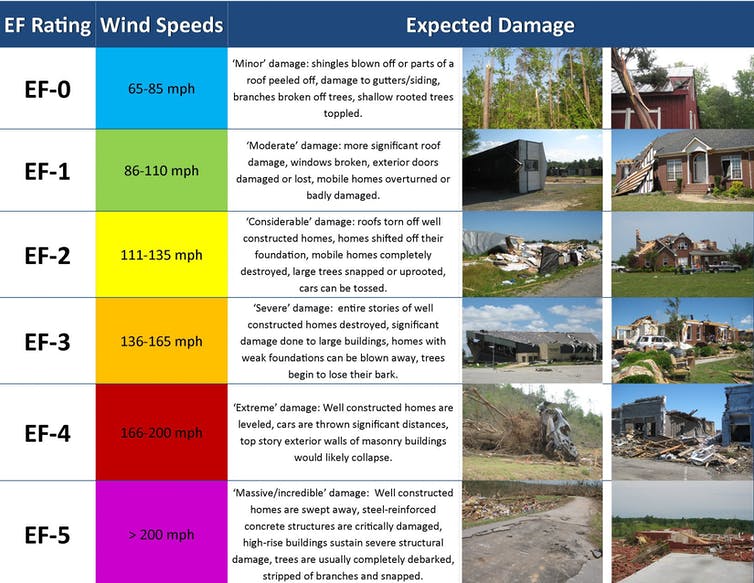On the night of December 10-11, 2021, a wave of powerful tornadoes swept through parts of Arkansas, Mississippi, Kentucky, Tennessee, and Illinois, killing dozens of people and leaving a trail of destruction of hundreds of kilometers. The climatologists specialized in risks Alisa Hass Y Kelsey Ellis They explain the conditions that generated this phenomenon and why the southeast is vulnerable to these disasters throughout the year, especially at night.
What factors came together to cause such a large surge?
On December 10, a powerful storm system approached the central United States from the west. While this system left heavy snowfall and rain in the cold west and north of the Midwest, the south was enjoying near-record heat, courtesy of warm, humid air flowing north from the Gulf of Mexico.
The storm system brought cold, dense air into the region, which interacted with the warm air, creating unstable atmospheric conditions. When warm and cold air masses collide, the less dense warm air rises towards the colder levels of the atmosphere. When this warm air cools, the moisture it contains condenses into clouds and can form storms.
When this instability is combined with a significant wind shear – winds that change direction and speed at different heights in the atmosphere – can create an ideal configuration for strong spinning storms.
>
On a tornado rating scale, how intense was it?
It has been reported at least 38 tornados in six states during this wave, which have caused widespread power outages, damage and fatalities. The United States National Weather Service classifies tornadoes based on the intensity of the damage using 28 damage indicators from the Enhanced Fujita scale or EF. Storm assessments and tornado ratings can take several days or more to complete.
Until December 12, they were confirmed at least four EF-3 and five EF-2 tornadoes. Tornadoes EF-2 and EF-3 are considered strong, with wind speeds of 179-218 km / h and 219-266 km / h respectively.
Strong straight-line winds also occur with severe storms and can cause as much damage as a tornado. Following storms and tornado records, the National Weather Service conducts damage studies in person to determine whether a tornado or winds caused the reported damage and the degree of destruction. The researchers will look to see if the debris is scattered in only one direction, which would indicate straight-line winds, or in many different directions, which characterizes a tornado.

National Weather Service
A tornado traveled 386 km through four states. Why is it unusual?
Most tornadoes stay on the ground for a short time and they travel short distances, from 5-6 kilometers on average. Long and very long trajectory tornadoes – those that travel at least 40 and 170 kilometers respectively– are relatively rare. Represent less than 1% of all tornadoes in the United States.
Long-distance tornadoes require a very specific set of ingredients that must exist in a wide area. These rare tornadoes are formed from a single supercell storm –A storm with a rotating updraft called mesocyclone– which can persist for hours.
More significant tornadoes tend to stay on the ground longer than weaker tornadoes. Their trajectories are especially long in the southeast, where major cold season tornadoes move quickly, thus covering more ground.
The previous record of a long-haul tornado was in 1925, when the F-5 Tri-State tornado traveled 352.45 kilometers through Missouri, Illinois and Indiana. The recent “four-state tornado,” as it has been dubbed, is expected to break that record. In the coming days, the US National Weather Service will confirm whether a tornado remained on the ground for more than 200 miles or if multiple tornadoes occurred from the same storm. The agency has issued a preliminary rating of EF-3 or higher for this phenomenon.
Why do more winter and night tornadoes occur in the southeastern United States?
Spring is typically considered tornado season, but tornadoes can strike at any time of the year. The southeastern United States experiences a second peak tornado activity in the fall and early winter, and winter tornadoes are not uncommon.
Also, tornadoes can strike at any time of the day. The nocturnal ones are especially common in the southeast, where ingredients for storms are different and more conducive to nighttime tornadoes than in the “Tornado Alley” (“Tornado alley”) in the Great Plains.
Tornado storms in the Southeast are typically driven by heavy wind shear. They do not depend as much on the rise of warm and humid air that creates atmospheric instability, conditions that require diurnal warming of the earth’s surface and that are more frequent in spring.
The forecast of this phenomenon was need and predicted a major surge several days in advance. The Storm Prediction Center the National Weather Service in Norman, Oklahoma, and affected National Weather Service local weather forecast offices issued timely advisories and warnings and information on staying safe.
But nighttime tornadoes can be especially deadly. More deaths tend to occur because people often you do not receive warning communications when he is sleeping. Storm detection is harder in the dark, and the people are more likely to be in more vulnerable homes, such as mobile homes, at night than during the day, when they are working on sturdier buildings.
Dispose of different reliable methods of receiving alerts at night This is essential, as power supply and mobile phone service can fail during bad weather. Unfortunately, during the phenomenon of December 10 and 11, some people who went to the shelters died when tornadoes hit the building where they were. But timely warnings that allow people to take refuge safely in a solid, well-founded structure can mean survival during less devastating events.
Alisa Hass, Assistant Professor of Geography, Middle Tennessee State University Y Kelsey Ellis, Associate Professor of Geography, University of Tennessee
This article was originally published on The Conversation. read the original.
Reference-www.eleconomista.com.mx